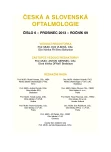Pars Plana Vitrectomy Due to the Intravitreal Hemorrhage Caused by Persistent Hyaloid Artery in Three Children
Authors:
J. Štěpánková; D. Dotřelová
Authors‘ workplace:
Oční klinika dětí a dospělých 2. LF UK a FNM, Praha, přednosta prof. MUDr. Dagmar Dotřelová, CSc., FEBO
Published in:
Čes. a slov. Oftal., 69, 2013, No. 6, p. 243-247
Category:
Original Article
Předneseno na 11. kongresu České vitreoretinální společnosti v Mikulově 25. 11. 2011
Overview
Purpose:
To report pars plana vitrectomy (PPV) of a vitreous hemorrhage (VH) as a complication of a persistent hyaloid artery (PHA) in three children. A persistent hyaloid artery is result of incomplete regression of embryonic hyaloid vascular system, and is mostly seen as the fibrotic remnants of the artery at the disc. Severity of a pathology varying from an asymptomatic course during a life to complications as an ambylopia, strabismus, cataract, nystagmus or intraocular bleeding, usually a vitreous hemorrhage. Changed vitreopapillary interface can troubled posterior vitreous detachment.
Methods:
Three case reports analyzed data of three children, 6-years-old and 10-years-old boys and 6-years-old girl, with VH and PHA treated by PPV with diathermy of partially regressed PHA in period from 2006 to 2011. There was unilateral, right side pathology in all children, all left eyes were normal. A traumatic origin, a blunt trauma and a bike accident respectivelly, was found in both boys. In a girl, she was the only patient, who was treated before VH for amblyopia, was no history of trauma.
Results:
Preoperative best corrected visual acuity (BCVA) varied between light perception to 6/9 and improved postoperatively to 6/9 – 6/6. We waited for spontaneous resolving of VH for four month in older boy, but it was complicated by other trauma (falling down at home) and recurrent bleeding. Progression of traumatic cataract in older boy 22 month postoperatively worsened BCVA to 6/60. Cataract surgery with implantation of an artificial posterior chamber lens and Nd: YAG laser capsulotomy improved BCVA to 6/6. An occlusion therapy was used in both 6-years-old children postoperatively. Postoperative average follow-up period is 54 month. There were no recurrent intraocular bleeding postoperatively.
Conclusion:
Pars plana vitrectomy removed VH not only as an optical barrier, but eliminated the vitreopapillary traction too. Timing of early vitrectomy eliminated risk of recurrent VH and the other complications.
Key words:
persistent hyaloid artery, vitreous hemorrhage, pars plana vitrectomy, children, vitreopapillary interface, vitreopapillary traction, amblyopia
Sources
1. Azrak, C., Campos-Mollo, E., Lledó-Riquelme, M., Ardoy Ibañez, F., Martinez Toldos, J.J.: Vitreous hemorrhage associated with persistent hyaloid artery, Arch Soc Esp Ophthalmol, 2011; 86, 10: 331–334.
2. Çekiç, O., Totan, Y., Batman, C.: Traumatic vitreous hemorrhage from a persistent hyaloid artery. J Pediatr Ophthalmol Strabismus, 2000; 37, 2: 117–118.
3. Delaney, WV.: Prepapillary hemorrhage and persistent hyaloid artery. Am J Ophthalmol, 1980; 90, 3: 419–421.
4. Gonçalves, A., Cruysberg, JRM., Draaijer, RW., Sellar, PW., Aandekerk, AL., Deutman, AF.: Vitreous haemorrhage and other ocular complications of a persistent hyaloid artery. Doc Ophthalmol, 1996; 92, 1: 55–59.
5. Chen, TL, Yarng, SS.: Vitreous hemorrhage from a persistent hyaloid artery. Retina, 1993; 13, 2: 148–151.
6. Önder F, Coşsar CB, Gültan E, Kural G.: Vitreous hemorrhage from the persistent hyaloid artery. J. AAPOS, 2000; 4, 3: 190–191.
7. Thumann, G., Bartz-Schmidt, KU, Kirchhof, B, Heimann, K.: Branch retinal artery occlusion by diathermy of a persistent hyaloid artery. Am J Ophthalmol, 1997; 124, 3: 415–416.
8. Williamson, W., Barac´h, D., Poirier, L., Coulon, P., Verin, P.: Hémorragie intravitréenne associée à une persistence de l´artère hyaloïde. J Fr Ophthalmol, 1994; 17, 5: 361–364.
9. Yap, EY., Buettner, H.: Traumatic rupture of a persistent hyaloid artery. Am J Ophthalmol, 1992; 17, 5: 361–364.
Labels
OphthalmologyArticle was published in
Czech and Slovak Ophthalmology

2013 Issue 6
Most read in this issue
- Vision Loss after Uncomplicated Pars Plana Vitrectomy
- Treatment Strategy of the Lacrimal Drainage System Inborn Obstruction. Part One – Conservative and Intervention Procedures
- Cytomegalovirus Retinitis in HIV Negative Patients – Retrospective Study
- Pars Plana Vitrectomy Due to the Intravitreal Hemorrhage Caused by Persistent Hyaloid Artery in Three Children
